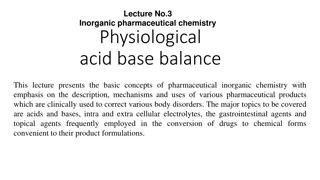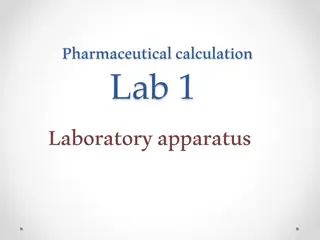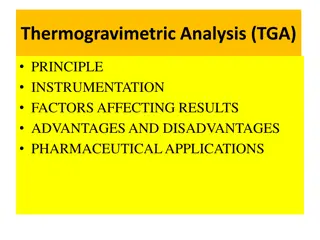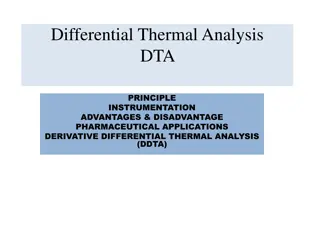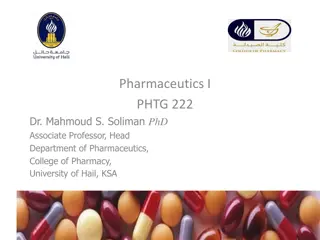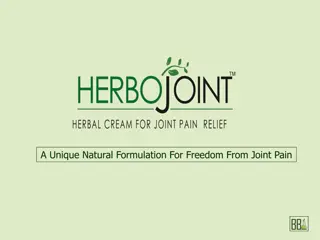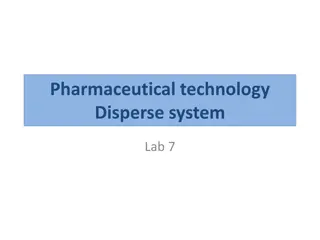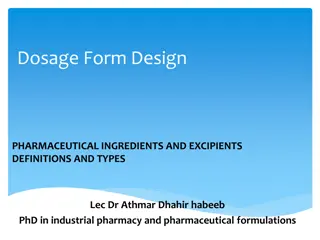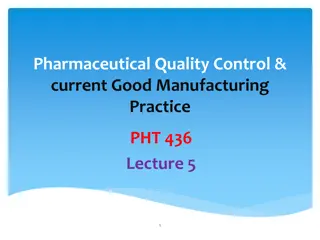Fundamentals of Material Science in Pharmaceutical Formulation
This chapter delves into key principles such as heat of vaporization, Fick's law, Noyes-Whitney equation, phase diagrams, solubility factors like particle size and pH adjustment in pharmaceutical formulation. Understanding these concepts is crucial for optimizing drug delivery systems.
Download Presentation

Please find below an Image/Link to download the presentation.
The content on the website is provided AS IS for your information and personal use only. It may not be sold, licensed, or shared on other websites without obtaining consent from the author.If you encounter any issues during the download, it is possible that the publisher has removed the file from their server.
You are allowed to download the files provided on this website for personal or commercial use, subject to the condition that they are used lawfully. All files are the property of their respective owners.
The content on the website is provided AS IS for your information and personal use only. It may not be sold, licensed, or shared on other websites without obtaining consent from the author.
E N D
Presentation Transcript
Chapter 4 Chapter 4 Extra materials
Heat of Vaporization heat of vaporization of liquid: is the amount of heat absorbed when 1 g of liquid vaporizes and measured in calories. The heat of vaporization of water at 100 C is 540 cal/g Ficks low govern absorption through membrane Noyes-Whitney equation govern dissolution rate. In the latter stages of preformulation testing or early formulation studies, animals and humans must be studied to assess absorption efficiency and pharmaco kinetic parameters and to establish possible in vitro and in vivo correlation for dissolution and bioavailability.
The Phase Rule Phase diagrams are used to provide visual picture of the existence and extent of the presence of solid and liquid phases in binary, ternary, and other mixtures.
The Phase Rule A phase diagram, or temperature composition diagram, represents the melting point as a function of composition of two or three component systems. The figure is an example of such a representation for a two- component mixture. This phase diagram depicts a two component mixture in which the components are completely miscible in the molten state and no solid solution or addition compound is formed in the solid state. As is evident, starting from the extremes of either pure component A or pure component B, as the second component is added, the melting point of the pure component decreases.
Solubility and Particle size The particle size and surface area of a drug exposed to a medium can affect actual solubility within reason, for example, in the following relationship:
Solubility and pH To formulate liquid product, should adjust the pH of solvent to enhance solubility. For many drug substances, pH adjustment is not an effective means of improving solubility. Weak acidic or basic drugs may require extremes in pH that are outside accepted physiologic limits or that may cause stability problems with formulation ingredients. Adjustment of pH usually has little effect on the solubility of substances other than electrolytes. In many cases, it is desirable to improve aqueous solubility by: 1-use cosolvents 2-complexation, 3-micronization, 4-solid dispersion. dissociation constant, or pKa , is usually determined by potentiometric titration.
Dissolution dissolution rate, or the time it takes for the drug to dissolve in the fluids at the absorption site, is the rate- limiting step in absorption. This is true for drugs administered orally in solid forms, such as tablets, capsules, or suspensions, and for those administered intramuscularly. When the dissolution rate is the rate-limiting step, anything that affects it will also affect absorption. Consequently, dissolution rate can affect the onset, intensity, and duration of response and control the overall bioavailability of the drug from the dosage form
Hydrates and Solvates Many active pharmaceutical agents exist as hydrates or solvates; some are hygroscopic, deliquescent, and/or efflorescent. Hygroscopic powders are those that will tend to absorb moisture from the air. Deliquescent powders are those that will absorb moisture from the air and even liquefy. Efflorescent powders are those that may give up their water of crystallization and may even become damp and pasty. When working with these powders, extra care must be taken.
if a hygroscopic or deliquescent powder is being weighed on a balance, the powder may absorb moisture from air and weigh heavier than it should. Therefore, weighings should be made quickly after opening the bulk chemical containers and then resealing them. Solvates and hydrates must be packaged in tight containers to prevent the loss or gain of moisture. In fact, it is best to have all chemicals stored in tight containers and to keep them closed at all times except for the short time when a weighing step is involved. Storage at the indicated temperatures is also important and to minimize any exposure to very high humidity levels.
organic Salt considerations Because many drugs are either weak acids or weak bases and have limited water solubility, they are often used as their salts to increase their aqueous solubility. For example: sodium salicylate is salt of weak acid, salicylic acid, and sodium hydroxide). Also, ephedrine hydrochloride can be prepared between a weak base, ephedrine, and hydrochloric acid. Generally, the unionized portion of drug in solution that will be absorbed for systemic effect. Active pharmaceutical ingredient (API) in a salt form is not 100% active drug, it is important to know whether or not the dose of drug is based upon drug salt or drug base form. The purpose of salt form is usually to enhance solubility of drug; but it may also enhance stability and change other attributes of the drug that make it easier to handle and manipulate for producing dosage forms.
Potency-Designated active Pharmaceutical ingredients API, is not 100% active drug in all cases. It is important to know the assayed potency designation of the ingredient so that appropriate allowances can be made to obtain the correct amount. This may be on the label or on the Certificate ofAnalysis. Some APIs, including some antibiotics, endocrine products, biotechnology-derived products, biologics, etc., have potencies that are based on activity and are expressed in terms of units of activity, micrograms per milligram, or other standard terms of measurements. These are described for eachAPI in USP.
oxidation, Chemically, oxidation is loss of electrons from atom or molecule. Each electron lost is accepted by some other atom or molecule, reducing the recipient. In inorganic chemistry, oxidation is accompanied by increase in positive valence of an element: for example, ferrous (+ 2) oxidizing to ferric (+ 3). In organic chemistry, oxidation is frequently considered synonymous with loss of hydrogen dehydrogenation) from molecule.
Zero-order rate reactions If the loss of drug is independent on concentration of reactants and constant with respect to time (i.e., 1 mg/mL/h), the rate is called zero order. The mathematical expression is
units for zero rate constant K0 are concentration per unit time such as: Mole/liter/ second or mg/ml/min It is meaningless to attempt to describe the time required for all material in a reaction to decompose that is infinity therefore reaction rate are commonly described by K or by their half life t1/2 The half life equation for a zero order reaction t1/2 = (C0/K0) If the C0 changes the t1/2 changes . There is inverse relationship between t1/2 and K
Example1 A drug suspension (125 mg/mL) decays by zero-order kinetics with a reaction rate constant of 0.5 mg/mL/h. What is the concentration of intact drug remaining after 3 days (72 hours), and what is its t1/2 ?
First order reactions If loss of drug is directly proportional to concentration remaining with respect to time, it is called a first-order reaction and has the units of reciprocal time, that is, time 1 The mathematical expression is:
and can be easily derived from first-order equation by substituting values of C = 50% and C0 = 100%, representing a decrease in concentration by 50%. Example 3 An ophthalmic solution of a mydriatic drug at 5 mg/mL exhibits first-order degradation with a rate of 0.0005/day. How much drug will remain after 120 days, and what is its half-life?
Example 4 In Example 3, how long will it take for drug to degrade to 90% of its original concentration?
Buffer Capacity pH, buffers, and buffer capacity are especially important in drug product formulation, since they affect the drug s solubility, activity, absorption, and stability and the patient s comfort. A buffer is a system, usually an aqueous solution, that can resist changes in pH upon addition of acid or a base. Buffers are composed of a weak acid and its conjugate base or a weak base and its conjugate acid. Buffers are prepared by one of these processes: 1. Mixing a weak acid and its conjugate base or a weak base and its conjugate acid 2. Mixing a weak acid and a strong base to form the conjugate base or a weak base and a strong acid to form the conjugate acid Using the Henderson-Hasselbalch equation: Remember that acid is the proton donor and the base is the proton acceptor.
Study stability of drug products by: 1. long-term storage at room temperature and relative humidity. 2. accelerated stability studies as indication of shelf life stability. Product containers, closures, and other packaging features must be considered in stability testing. For instance, tablets or capsules packaged in glass or plastic bottles require different stability test protocols from those for blister packs or strip packaging. Stability testing is to provide evidence on how the quality of a drug product varies with time under the influence of environmental factors, such as temperature, humidity, oxidation, light and microbial exposure. Stability testing is also used to establish the shelf life for a drug product and recommended storage conditions
Drug product: The dosage form in the final immediate packaging intended for marketing. Drug substance: The unformulated drug substance that may subsequently be formulated with excipients to produce dosage form. Excipient: Anything other than the drug substance in dosage form. Expiration date: The date placed on container label of drug product designating the time prior to which a batch of the product is expected to remain within approved shelf life specification, if stored under defined conditions, and after which it must not be used. Shelf life (also referred to as expiration dating period):The time period during which a drug product is expected to remain within the approved shelf life specification, provided that it is stored under the conditions defined on container label.
Stress testing (drug substance): Studies undertaken to elucidate the intrinsic stability of a drug substance. Such testing is part of the drug development process and is normally carried out under more severe conditions than those used for accelerated testing. Stress testing (drug product):Studies undertaken to assess the effect of severe conditions on drug product. Such studies include photostability testing as well as the specific testing of certain product types (e.g., metered dose inhalers, creams, emulsions). For the drug substance, the testing should evaluate its susceptibility to hydrolysis across a wide range of pH values when in solution or suspension. Photo stability testing should be an integral part of stress testing.
Data should be obtained from at least three pilot-scale batches of the drug substance, manufactured by the method and procedures that mirror the process to be used for final full-scale production batches. Stability studies also should be conducted on drug substance packaged in the container closure system that is the same or simulates the packaging proposed for final product. on at least three batches of manufactured dosage form, packaged in the container and closure system, including all secondary packaging (e.g., outer carton) proposed for marketing. The studies should include susceptible to change during storage, thereby affecting quality and efficacy. testing product that
Following FDA product approval and initial marketing, pharmaceutical manufacturers samples of drug/drug product for 5 years or longer and continue studies for signs of degradation under various conditions of storage. Pharmacy practitioners should also observe signs of product instability (e.g., color change, distorted capsules, softened tablets, etc.) and report such findings. retain production
USP guidelines on stability USP guidelines on stability USP guidelines on stabilitystate that in the absence of stability information applicable to a specific drug and preparation, the following guidelines can be used: non aqueous liquids and solid formulations when manufactured drug is the source of the active ingredient, not later than 25% of the time remaining until the product s expiration date or 6 months; non aqueous liquids and solid formulations in which a USP or National Formulary (NF) substance is the source of active ingredient, a beyond-use date of 6 months; for water-containing formulations prepared from beyond-use date not later than 14 days in storage at cold temperatures; for all other formulations, a beyond-use date of intended duration of therapy or 30 days. Thus, if oral aqueous liquid preparation is made from a tablet or capsule formulation, the pharmacist should make up only at most 14 days supply, and it must be stored in a refrigerator. Furthermore, the pharmacist must dispense the medication in a container conducive to stability and use and must advise the patient of proper method of use and conditions of storage of the medication ingredients in solid form, a


